Wingspan 14 m Introduced 1937 Number of seats 3 | Length 9.9 m First flight 1936 Manufacturers Fieseler, Morane-Saulnier | |
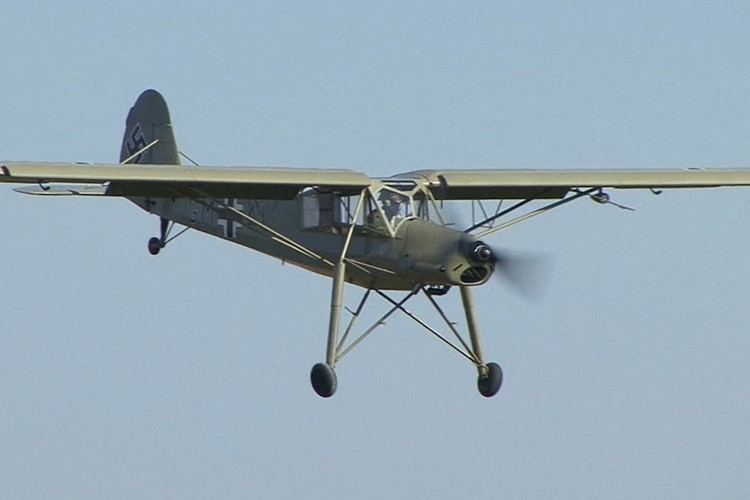 | ||
Fieseler fi 156 storch demo 1938
The Fieseler Fi 156 Storch (English: Stork) was a small German liaison aircraft built by Fieseler before and during World War II. Production continued in other countries into the 1950s for the private market. It remains famous for its excellent STOL performance; French-built later variants often appear at air shows.
Contents
- Fieseler fi 156 storch demo 1938
- 1937 fieseler fi 156 storch demo flown by kermit weeks
- Conception and production
- German production
- Soviet production
- Czech production
- French production
- Romanian production
- Summary of production
- Modern development
- During World War II
- Post World War II
- Variants
- Austria
- Belgium
- Finland
- Germany
- Norway
- Serbia
- South Africa
- Spain
- Switzerland
- United Kingdom
- United States
- Operators
- Specifications Fi 156
- References
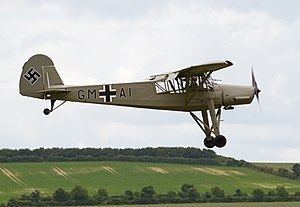
1937 fieseler fi 156 storch demo flown by kermit weeks
Conception and production
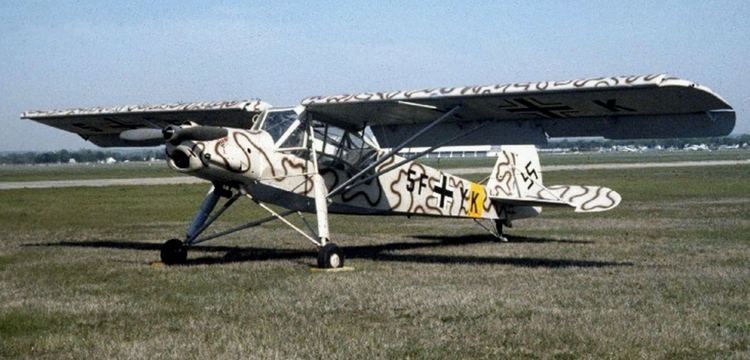
In 1935, the RLM (Reichsluftfahrtministerium, Reich Aviation Ministry) invited tenders from several companies for a new Luftwaffe aircraft suitable for liaison, army co-operation (today called forward air control), and medical evacuation. This resulted in the Messerschmitt Bf 163 and Siebel Si 201 competing against the Fieseler firm's tender. Conceived by chief designer Reinhold Mewes and technical director Erich Bachem, Fieseler's design had a far better short take off and landing ("STOL") performance. A fixed slat ran along the entire length of the leading edge of the long wings, while a hinged and slotted set of control surfaces ran along the entire length of trailing edge. This was inspired by earlier 1930s Junkers Doppelflügel, "double-wing" aircraft wing control surface design concepts. For the Fi 156, this setup along each wing panel's trailing edge was split nearly 50/50 between the inboard-located flaps and outboard-located ailerons, which themselves included trim tab devices over half of each aileron's trailing edge length.
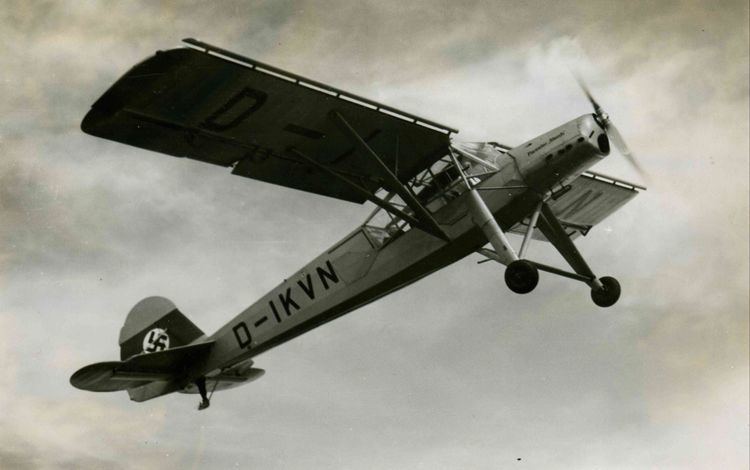
A design feature rare for land-based aircraft enabled the wings on the Storch to be folded back along the fuselage in a manner similar to the wings of the US Navy's Grumman F4F Wildcat fighter. This allowed the aircraft to be carried on a trailer or even towed slowly behind a vehicle. The primary hinge for the folding wing was located in the wing root, where the rear wing spar met the cabin. The long legs of the main landing gear contained oil-and-spring shock absorbers that had a travel of 40 cm (15-3/4 inches), allowing the aircraft to land on comparatively rough and uneven surfaces - this was combined with a "pre-travel" distance of 20 cm, before the oleos began damping the landing gear shock. In flight, the main landing gear legs hung down, giving the aircraft the appearance of a long-legged, big-winged bird, hence its nickname, Storch. With its very low landing speed the Storch often appeared to land vertically, or even backwards, in strong winds from directly ahead.
German production

About 2,900 Fi 156s, mostly Cs, were produced from 1937 to 1945 at the Fieseler Factory in Kassel. In 1942, production started in the Morane-Saulnier factory at Puteaux in France. Due to the demand for Fieseler as a subcontractor for building the Bf 109 and the Fw 190, Storch production was shifted to the Leichtbau Budweis in Budweis in 1943.
Soviet production
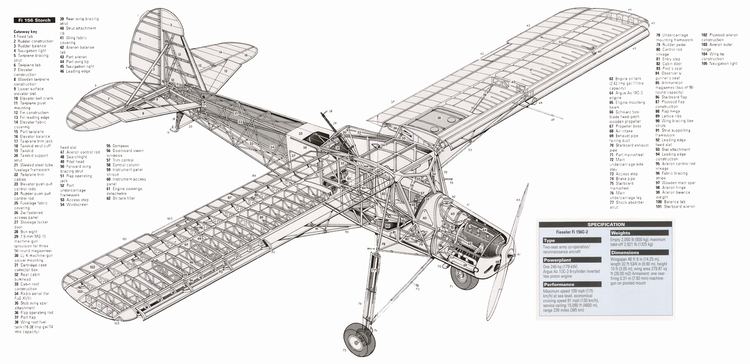
In 1939, after the signing of the Molotov-Ribbentrop Pact, Germany provided several aircraft, including the Fi 156C, to the Soviet Union. Oleg Antonov was made responsible for putting the aircraft into production to meet Soviet requirements, and given a choice between designing an equivalent aircraft or merely copying the German design, the latter was selected. Two versions were envisaged: the SS three seat liaison aircraft, and the N-2 air ambulance capable of carrying two stretchers plus a medic. A prototype was constructed in Kaunas, Lithuania, which flew before the end of 1940, and production was getting under way as the factory was lost to the German advance in 1941. While Antonov's efforts had produced a heavier aircraft, which required as much as three times the field for landing and take off as the German Fi 156C, it also had much greater range and increased load capability. After the war Antonov went on to design the legendary An-2, which was similarly famous for its excellent STOL performance.
Czech production
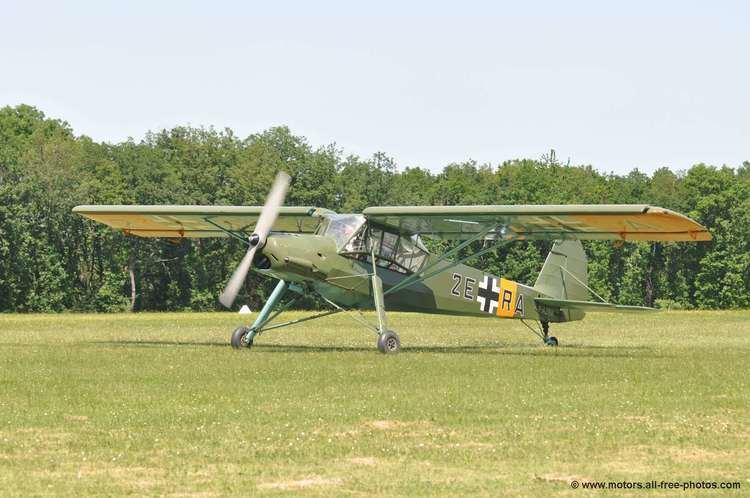
In 1944 production was moved from the Leichtbau Budweis to the Mráz factory in Chocen which produced 138 examples of the Fi 156, locally designated as "K-65 Čáp". Production ended in 1949.
French production
Immediately after the liberation of France in 1944, the production of Fi 156 at the Morane-Saulnier factory was continued at the request of the Armée de l'Air and designated MS 500 for the batch of aircraft produced with the remaining stock of Argus engines. Further modifications and use of different engines (inline and radial) are known under different type numbers. The use of the aircraft in Indochina highlighted the weakness of the wood in the construction of the airframe; it was then decided to build the wings of metal. Among the modifications, the defensive weapon aiming through the back window was dropped, although some aircraft were modified in the field to take a machine gun MAC 34T firing through one of the side windows. Some 141 aircraft were built before the end of World War II, and a total of 925 aircraft were built before the end of the production of all types of Criquet by Morane-Saulnier in 1965.
Romanian production
Licence production was also started in Romania in October 1943 at the ICAR factory in Bucharest. Only 10 were built by the time the ICAR factory was bombed in May 1944. Production resumed later in 1944 but only six were completed before repair work halted production. From June 1945 until 1946, a further 64 aircraft were built.
Summary of production
Production per factory and per type until 31 March 1945:
Modern development
Because of its superb STOL characteristics, there have been many attempts to recreate or copy the Storch, mainly in the form of various ¾ scale homebuilt aircraft such as the Pazmany PL-9 Stork and Roger Mann's RagWing RW19 Stork.
As an example, the Slepcev Storch is a ¾ scale reproduction of the original with some simplifications. The use of modern materials provides better STOL performance than the original with a take-off run of 30 m and landing-roll of 50 m with no headwind. It was originally designed and manufactured in Australia and is now manufactured in Serbia.
During World War II
The Storch was deployed in all European and North African theaters of World War II, but it is probably most famous for its role in Operation Eiche, the 1943 rescue of deposed Italian dictator Benito Mussolini from a boulder-strewn mountain-top near the Gran Sasso. Even though the mountain was surrounded by Italian troops, German commando Otto Skorzeny and 90 paratroopers used gliders to land on the peak and quickly captured it. But the problem of how to get back off remained. A Focke-Achgelis Fa 223 helicopter was sent, but it broke down en route. Instead, pilot Heinrich Gerlach flew in a Storch. It landed in 30 m (100 ft), and after Mussolini and Skorzeny boarded, it took off in 80 m (250 ft), even though the aircraft was overloaded. The Storch involved in rescuing Mussolini bore the radio code letters, or Stammkennzeichen, of "SJ + LL" in the motion picture coverage of the daring rescue.
On 26 April 1945, a Storch was one of the last aircraft to land on the improvised airstrip in the Tiergarten near the Brandenburg Gate during the Battle of Berlin and the death throes of the Third Reich. It was flown by the test pilot Hanna Reitsch, who flew Generalfeldmarschall Robert Ritter von Greim from Munich to Berlin to answer a summons from Hitler.
A Storch was the victim of the last dog fight on the Western Front and another was downed by a direct Allied counterpart of the Storch, an L-4 Grasshopper, the military version of the well-known American Piper J-3 Cub civilian training and sport aircraft. The pilot and co-pilot of the L-4, lieutenants Duane Francis and Bill Martin, opened fire on the Storch with their .45 caliber pistols, forcing the German air crew to land and surrender.
Field Marshal Rommel used Storch aircraft for transport and battlefield surveillance during the North African desert campaign of World War II.
During the war a number of Storches were captured by the Allies. One became the personal aircraft of Field Marshal Montgomery. Others were used as the personal aircraft of Air Vice Marshal Arthur Coningham and Air Vice Marshal Harry Broadhurst, who acquired his Storch in North Africa, and flew it subsequently in Italy and North-West Europe.
The British captured 145, of which 64 were given to the French as war compensation from Germany.
Post World War II
The French Air Force (Armée de l'Air) and the French Army Light Aviation (Aviation Légère de l’Armée de Terre) used the Criquet from 1945 to 1958 throughout the Indochina War and the Algerian War. The Swiss Air Force and other mountainous European countries continued to use the Storch for rescues in terrain where STOL performance was necessary, as with the historically significant Gauli Glacier crash rescue in November 1946, as a pair of Flugwaffe-flown Storches were the sole means to get its twelve survivors to safety. After World War II, Storch aircraft were used in utility roles including agricultural spraying. Many Storches are still operational today and are commonly shown at air shows. In North America, both the Collings Foundation and the Fantasy of Flight museum have airworthy Fi 156 Storch aircraft in their collections.
Variants
Austria
Belgium
Finland
Germany
Norway
Serbia
South Africa
Spain
Switzerland
United Kingdom
United States
Operators
Specifications (Fi 156)
Data from
General characteristics
Performance
Armament
